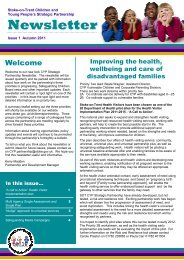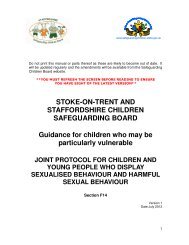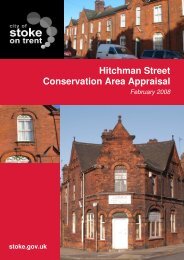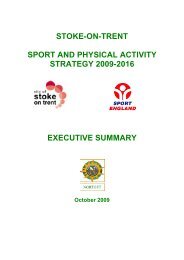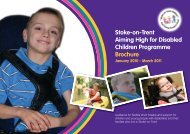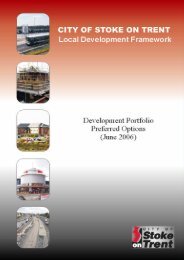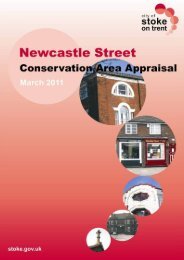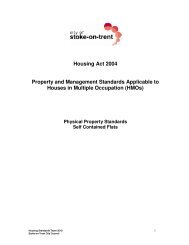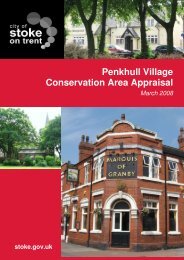Director of Public Health Annual Report 2012 [pdf] - Stoke-on-Trent ...
Director of Public Health Annual Report 2012 [pdf] - Stoke-on-Trent ...
Director of Public Health Annual Report 2012 [pdf] - Stoke-on-Trent ...
Create successful ePaper yourself
Turn your PDF publications into a flip-book with our unique Google optimized e-Paper software.
Alcohol admissi<strong>on</strong>s<br />
For many people, having a drink remains a harmless and enjoyable part <str<strong>on</strong>g>of</str<strong>on</strong>g> their lives.<br />
However, this is not the case for every<strong>on</strong>e. In <str<strong>on</strong>g>Stoke</str<strong>on</strong>g>-<strong>on</strong>-<strong>Trent</strong>, in 2008/2009, it was estimated<br />
that 25% <str<strong>on</strong>g>of</str<strong>on</strong>g> adults (aged 16 and over) were ‘increasing and high risk’ drinkers. This is higher<br />
than the estimated average in England <str<strong>on</strong>g>of</str<strong>on</strong>g> 22.3% <str<strong>on</strong>g>of</str<strong>on</strong>g> adults.<br />
In 2010/2011, there were nearly 1.2 milli<strong>on</strong> hospital admissi<strong>on</strong>s for alcohol-related harm in<br />
England. Such excesses can have serious health and social c<strong>on</strong>sequences for drinkers.<br />
Excessive drinking is associated with higher death rates from circulatory disease, cirrhosis <str<strong>on</strong>g>of</str<strong>on</strong>g><br />
the liver, stomach cancers, suicides and violence. Similarly, the health <str<strong>on</strong>g>of</str<strong>on</strong>g> others is affected<br />
by such excesses through increases in physical and sexual assaults, crime, motor accidents,<br />
domestic abuse, child abuse and breakdowns in marriages.<br />
Mortality rates from alcohol-specific (and alcohol-attributable) c<strong>on</strong>diti<strong>on</strong>s in <str<strong>on</strong>g>Stoke</str<strong>on</strong>g>-<strong>on</strong>-<strong>Trent</strong><br />
are higher than the England average, as are<br />
hospital admissi<strong>on</strong> rates. Hospital admissi<strong>on</strong> rates There were 5,645 hospital<br />
and mortality are higher locally am<strong>on</strong>g males, admissi<strong>on</strong>s for alcohol related harm<br />
in 2010/2011<br />
whilst there has also been an increase in mortality<br />
and admissi<strong>on</strong> rates over the past five years (am<strong>on</strong>g both males and females). Across a<br />
number <str<strong>on</strong>g>of</str<strong>on</strong>g> other indicators, such as mortality from chr<strong>on</strong>ic liver disease, alcohol-related<br />
recorded crime and violent crime, rates are higher in <str<strong>on</strong>g>Stoke</str<strong>on</strong>g>-<strong>on</strong>-<strong>Trent</strong> compared with<br />
England.<br />
Locally, the cost <str<strong>on</strong>g>of</str<strong>on</strong>g> alcohol related hospital admissi<strong>on</strong>s in 2010/2011 was £14.9m. Based <strong>on</strong><br />
a nati<strong>on</strong>al indicator, the hospital admissi<strong>on</strong>s rate for alcohol related harm in <str<strong>on</strong>g>Stoke</str<strong>on</strong>g>-<strong>on</strong>-<strong>Trent</strong><br />
was 2,058.9 (per 100,000 populati<strong>on</strong>, all ages) in 2010/2011 (compared with 1,895.2 in<br />
England). This means there were 5,645 hospital admissi<strong>on</strong>s for alcohol related harm locally<br />
in 2010/2011. Having said this, whilst the admissi<strong>on</strong> rate in <str<strong>on</strong>g>Stoke</str<strong>on</strong>g>-<strong>on</strong>-<strong>Trent</strong> remains above<br />
the nati<strong>on</strong>al average, the local rate is the lowest it has been since 2005/2006, and the gap in<br />
the rate between <str<strong>on</strong>g>Stoke</str<strong>on</strong>g>-<strong>on</strong>-<strong>Trent</strong> and England c<strong>on</strong>tinues to reduce.<br />
Drug addicti<strong>on</strong><br />
Drug addicti<strong>on</strong> leads to significant crime, health and social costs; drug treatment reduces<br />
this and lowers the number <str<strong>on</strong>g>of</str<strong>on</strong>g> both drug-related deaths and the rate <str<strong>on</strong>g>of</str<strong>on</strong>g> blood-borne<br />
diseases. When engaged in treatment, people use fewer illegal drugs, commit less crime,<br />
improve their health, and manage their lives better which also benefits the community.<br />
Preventing early drop out and keeping people in treatment l<strong>on</strong>g enough to benefit<br />
c<strong>on</strong>tributes to these improved outcomes. As people progress through treatment, the benefits<br />
to them, their families and the community start to accrue.<br />
In <str<strong>on</strong>g>Stoke</str<strong>on</strong>g>-<strong>on</strong>-<strong>Trent</strong> in 2011/12, 1,533 crack and opiate users were engaged in effective<br />
treatment. Hepatitis B (HBV) vaccinati<strong>on</strong>s were accepted by 73% <str<strong>on</strong>g>of</str<strong>on</strong>g> people new to treatment<br />
compared to 48% nati<strong>on</strong>ally; 85% were tested for hepatitis C, compared to 70% nati<strong>on</strong>ally<br />
and 57 people also received treatment for hepatitis C in community clinics jointly delivered<br />
by the University Hospital North Staffordshire and the community drug service.<br />
30 | P a g e


![Director of Public Health Annual Report 2012 [pdf] - Stoke-on-Trent ...](https://img.yumpu.com/32721490/32/500x640/director-of-public-health-annual-report-2012-pdf-stoke-on-trent-.jpg)
